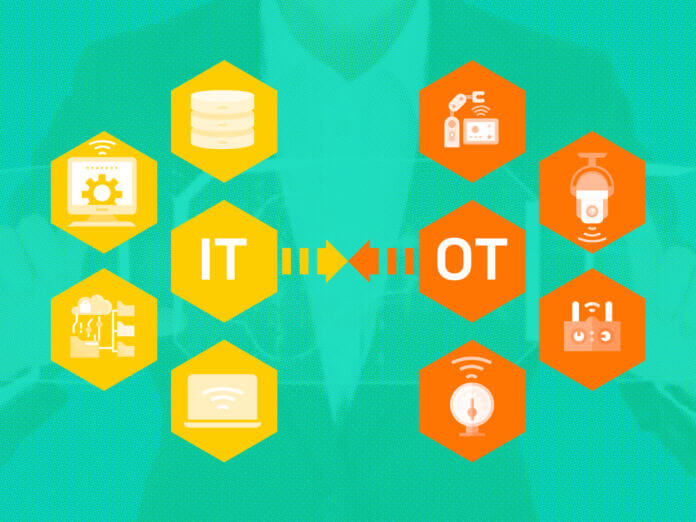
Heavy industries like manufacturing are in the middle of a massive digital transformation. Part of that shift is a practice called IT/OT convergence, which comes with some unique security risks. The Internet of Things (IoT) could be what businesses need to tackle those concerns.
What Is IT/OT Convergence?
IT/OT convergence is the combination of information technology (IT) and operational technology (OT). It deals with data and digital processes, covering things like computers, office software, cloud platforms, and internet networks. OT deals with physical processes — think industrial machinery and their sensors and controllers.
Historically, IT and OT have been entirely separate. However, that’s starting to change as more organizations realize how valuable their OT data could be. Harnessing that knowledge through IT/OT convergence can add more than $100 million in value by unlocking technology’s full potential.
This convergence can take many forms. Businesses may gather data from industrial machines and analyze it with IT software to learn when to repair them or see how much energy they use. They could also use IT solutions to program OT hardware to work more efficiently. At the far end of the scale, they could apply artificial intelligence (AI) to industrial infrastructure.
The Role of IoT
IoT plays a crucial role in IT/OT convergence. IoT devices themselves are a small-scale form of this concept, as they apply the data-centric applications of IT to the physical processes of OT.
IoT connectivity also provides a way to connect IT hardware like office computers to a company’s OT. That way, businesses can monitor or control their industrial machinery from a separate device in real-time. Alternatively, they could use IoT standards to connect all the OT on a factory floor so automated machines can work together effectively.
Security Considerations for IT/OT Convergence
IT/OT convergence has many benefits. It lets enterprises use their resources more efficiently, find improvement areas, become more productive, and prevent equipment breakdowns. At the same time, it also introduces some security concerns many of these industries haven’t had to worry about before.
Rising IT/OT convergence has led to expanding attack surfaces — cybercriminals have more ways to target companies than ever. Before, industrial machinery wasn’t a cybersecurity concern because hackers could not access it. Now that this machinery is online, attackers can hack into it and use it to jump to other, more sensitive devices on the same network.
Even if OT infrastructure doesn’t connect to IT devices with sensitive data, bringing it online poses risks. Attackers could gain remote control over heavy machinery. All of a sudden, cybersecurity becomes a matter of physical safety.
Securing these now-online OT endpoints can be tricky, too. The machines don’t have software that can support traditional IT security tools and they’re easy to overlook because they haven’t been at risk for so long.
How the IoT Enables Secure IT/OT Convergence
While the IoT has plenty of security issues, it can play an important role in securing IT/OT convergence. That’s because it enables a few crucial cybersecurity processes.
Standardization
The most basic of these steps is to bring some needed standardization to OT networks. One of the reasons why OT is so hard to secure is it’s usually not compatible with the same programs and controls as IT. This is a big problem for security as a whole, with 61% of organizations having to use three to six different tools to detect threats across the network.
Connecting OT hardware to IT networks through the IoT solves this issue. While the OT itself may be incompatible with security software, an IoT device businesses use to control it likely is. Companies can apply the same standards and tools to their network by using compatible IoT platforms to connect everything.
Real-Time Network Monitoring
Because IoT devices analyze real-time data, they also enable more in-depth monitoring. Organizations can use IoT devices to scan their OT to see how data moves in and out normally. That way, they can quickly identify suspicious activity and track movement to respond to potential breaches and stop them from spreading.
IoT devices can automatically disconnect when network monitoring tools detect a potential threat. That way, they can isolate a compromised OT endpoint, making it impossible for attackers to jump from one place to another. Security pros can then handle the issue without worrying about broader damage.
Edge Computing
The IoT also paves the way for edge computing, where networks distribute computing tasks across nearby devices. The advantage here is businesses execute IT/OT convergence tasks closer to the data’s source. Information doesn’t have to travel to a far-away data center or even a remote computer, reducing attackers’ chances to intercept it.
Edge computing can also improve access latency by 30% because data doesn’t have to travel as far. That speed boost leaves even less room for attackers to get in and ensures monitoring tools can detect suspicious activity faster.
The IoT Can Bring IT and OT Together Safely
The IoT is essential in IT/OT convergence, making it practical and secure. Industrial organizations must pay attention to this potential if they want to capitalize on new technologies without increasing their vulnerability.
When IT and OT can work together securely, they unlock significant benefits. The key is to use the IoT to bridge the gap between them and do so safely.
- SEO Powered Content & PR Distribution. Get Amplified Today.
- PlatoData.Network Vertical Generative Ai. Empower Yourself. Access Here.
- PlatoAiStream. Web3 Intelligence. Knowledge Amplified. Access Here.
- PlatoESG. Carbon, CleanTech, Energy, Environment, Solar, Waste Management. Access Here.
- PlatoHealth. Biotech and Clinical Trials Intelligence. Access Here.
- Source: https://www.iotforall.com/iot-is-the-essential-mediator-for-secure-it-ot-convergence
- :has
- :is
- :not
- :where
- $100 million
- 1
- a
- About
- access
- across
- activity
- add
- ADvantage
- AI
- All
- also
- an
- analyze
- and
- Another
- applications
- Apply
- ARE
- areas
- artificial
- artificial intelligence
- Artificial intelligence (AI)
- AS
- At
- attack
- attackers
- attention
- Automated
- automatically
- basic
- BE
- because
- become
- becomes
- been
- before
- benefits
- between
- Big
- boost
- breaches
- BRIDGE
- bring
- Bringing
- broader
- businesses
- by
- called
- CAN
- capitalize
- Center
- chances
- change
- closer
- Cloud
- combination
- comes
- Companies
- Company’s
- compatible
- Compromised
- computer
- computers
- computing
- concept
- Concern
- Concerns
- Connect
- considerations
- control
- controls
- Convergence
- could
- covering
- crucial
- cybercriminals
- Cybersecurity
- damage
- data
- Data Center
- Deals
- detect
- device
- Devices
- different
- digital
- distribute
- do
- Doesn’t
- Dont
- easy
- Edge
- edge computing
- effectively
- efficiently
- enable
- enables
- end
- Endpoint
- endpoints
- energy
- ensures
- enterprises
- entirely
- equipment
- essential
- Even
- EVER
- everything
- execute
- expanding
- factory
- far
- faster
- few
- Find
- Floor
- For
- form
- forms
- from
- full
- Gain
- gap
- gather
- get
- hack
- hackers
- had
- handle
- Hard
- Hardware
- Harnessing
- Have
- having
- heavy
- here
- How
- However
- HTTPS
- identify
- IEEE
- if
- important
- impossible
- improvement
- in
- in-depth
- incompatible
- increasing
- industrial
- industries
- information
- information technology
- Infrastructure
- Intelligence
- Internet
- Internet networks
- internet of things
- into
- Introduces
- iot
- IoT Device
- iot devices
- issue
- issues
- IT
- it security
- itself
- jpg
- jump
- Key
- knowledge
- Latency
- LEARN
- leaves
- Led
- less
- Lets
- like
- likely
- Long
- machinery
- Machines
- Making
- manufacturing
- many
- massive
- Matter
- max-width
- May..
- McKinsey
- Middle
- million
- Monitor
- monitoring
- more
- most
- movement
- moves
- much
- must
- Need
- needed
- network
- networks
- New
- New technologies
- normally
- now
- of
- Office
- on
- ONE
- online
- operational
- or
- organizations
- ot
- Other
- out
- over
- part
- paves
- Pay
- physical
- Place
- Platforms
- plato
- Plato Data Intelligence
- PlatoData
- Play
- plays
- Plenty
- poses
- potential
- Practical
- practice
- prevent
- Problem
- processes
- productive
- Program
- Programs
- PROS
- provides
- quickly
- real-time
- real-time data
- realize
- reasons
- reducing
- remote
- repair
- Resources
- Respond
- Risk
- risks
- Role
- Room
- safely
- Safety
- same
- Scale
- scan
- secure
- securely
- securing
- security
- security risks
- Security software
- security tools
- see
- sensitive
- sensors
- separate
- shift
- significant
- SIX
- So
- Software
- Solutions
- Solves
- some
- Source
- speed
- Spreading
- standardization
- standards
- Starting
- Steps
- Stop
- sudden
- support
- suspicious
- tackle
- Take
- Target
- tasks
- Technologies
- Technology
- than
- that
- The
- their
- Them
- themselves
- then
- These
- they
- things
- Think
- this
- those
- threat
- threats
- three
- Through
- time
- to
- together
- too
- tools
- track
- traditional
- travel
- tricky
- unique
- unlock
- unlocking
- use
- using
- usually
- Valuable
- vulnerability
- want
- Way..
- ways
- What
- when
- which
- while
- whole
- why
- with
- without
- Work
- work together
- worry
- worrying
- zephyrnet










